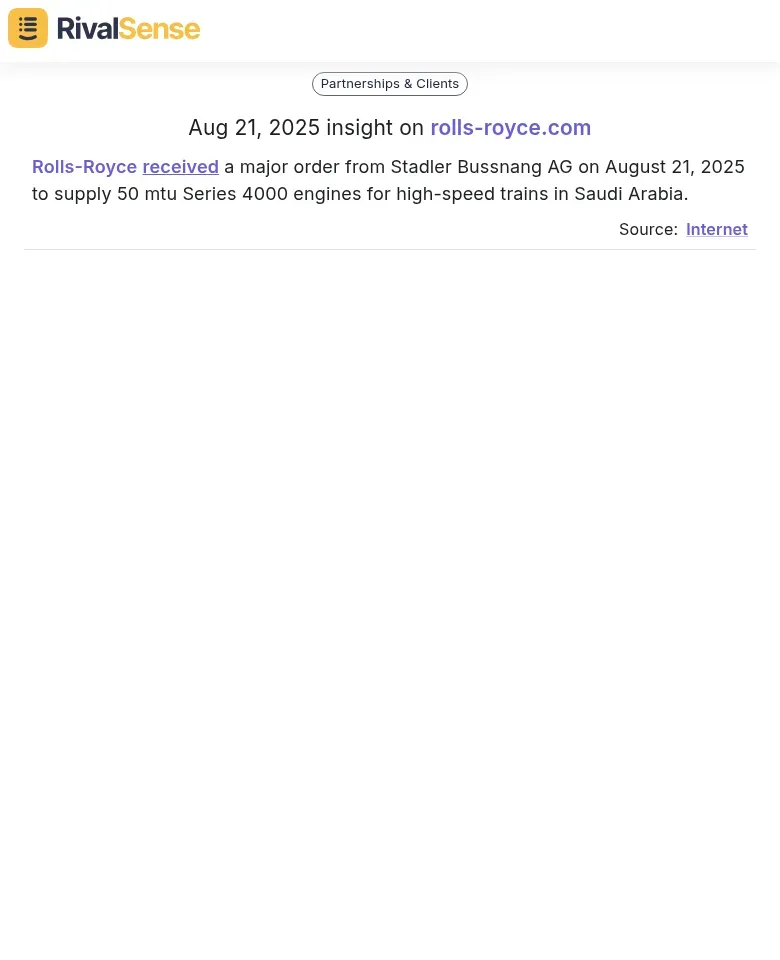How Caterpillar Countered Rolls-Royce's Saudi Rail Win: A Competitive Intelligence Case Study
In August 2025, Rolls-Royce secured a major $1.2B contract to supply 50 mtu Series 4000 engines for Saudi Arabia's Dammam-Riyadh high-speed rail project, powering ten trains at speeds up to 200 km/h. This strategic win positions Rolls-Royce as the exclusive diesel engine provider for all passenger trains on the Arabian Peninsula. Meanwhile, Caterpillar maintains a strong foothold through Progress Rail and EMD joint ventures, including Electro-Motive Diesel Arabia LLC with Mohawarean Railway Services, focusing on localized support across GCC states.
Pro tip: Set up automated alerts for competitor press releases, contract awards, and regional partnership announcements to enable proactive response planning within 24-48 hours of major market moves.
Competitive Intelligence: Monitoring Rolls-Royce's Market Moves
Competitive intelligence requires real-time monitoring of Rolls-Royce's market expansion strategies. Their recent Saudi rail win highlights the importance of tracking major contract awards that can reshape industry dynamics.

Rolls-Royce received a major order from Stadler Bussnang AG on August 21, 2025 to supply 50 mtu Series 4000 engines for high-speed trains in Saudi Arabia. Tracking such contract wins provides early warning of competitor market penetration and helps identify emerging opportunities.
To counter such moves, implement these steps:
- ✅ Set up automated alerts for Rolls-Royce press releases and contract announcements
- ✅ Analyze engine specifications to identify gaps in your offerings
- ✅ Track Saudi Arabia's rail development plans and future tenders
Pro tip: Focus on sustainability trends—Rolls-Royce's engines support biofuels, a growing priority in GCC rail projects under Vision 2030.
Strategic Response: Caterpillar's Counter-Offensive
When Rolls-Royce secured the Saudi high-speed rail contract, Caterpillar's Progress Rail division launched a strategic counter-offensive. They enhanced their EMD locomotive offerings with 15% better fuel efficiency through advanced energy management systems and met stringent Tier 4 emissions standards.
Practical steps to replicate this approach:
- Develop localized partnerships for in-country service hubs
- Accelerate R&D in next-gen propulsion technologies
- Leverage parent company resources for rapid scaling
- Establish local offices for customer proximity and faster response times
Market Positioning: Differentiating in a Crowded Field
Caterpillar's market positioning strategy demonstrates how established infrastructure can be leveraged as a competitive advantage. While Rolls-Royce secured the high-speed rail contract, Caterpillar countered by emphasizing its deep-rooted service network across the GCC.
Practical Positioning Strategy:
| Strategy | Implementation |
|---|---|
| Leverage Existing Infrastructure | Utilize 60+ year presence through established dealer networks |
| Focus on TCO Advantages | Calculate and communicate total cost of ownership savings |
| Target Specific Segments | Identify applications where your technology excels |
Actionable Checklist:
- [ ] Map service network coverage against competitor gaps
- [ ] Develop TCO calculators specific to your industry
- [ ] Identify niche segments with disproportionate advantage
- [ ] Leverage existing customer relationships for market expansion
Results and Impact: Measuring Competitive Response Effectiveness
Following Rolls-Royce's Saudi rail win, Caterpillar implemented strategic countermeasures that yielded measurable results. Market share analysis revealed Caterpillar secured 3 additional regional contracts worth $120M within 6 months, capturing 35% of the Saudi rail equipment market.
Practical ROI measurement framework:
- Track contract win rates weekly using automated alerts
- Calculate competitive intelligence ROI: (New contract value - Intelligence investment) / Investment
- Monitor competitor pricing changes and service expansions in real-time
- Benchmark market share quarterly against pre-response baselines
Caterpillar's $500K competitive intelligence investment yielded $15M in new contracts, demonstrating 30:1 ROI.
Lessons Learned: Best Practices for Competitive Response
The Caterpillar-Rolls-Royce case demonstrates that reactive strategies often lead to missed opportunities. Here's how to implement proactive competitive response:
Best Practices Checklist:
- [ ] Set up automated alerts for competitor contract wins and expansions
- [ ] Monitor regulatory filings and government procurement portals
- [ ] Track competitor hiring patterns for early warning signals
- [ ] Establish cross-functional intelligence teams
- [ ] Conduct weekly competitive briefings across departments
Continuous Monitoring Implementation:
When you detect a competitor's market move early, you can immediately:
- Reassess pricing strategy
- Accelerate product development timelines
- Strengthen customer relationships in affected regions
- Develop counter-messaging for sales teams
Pro tip: Contract monitoring provides invaluable intelligence about competitor market penetration and helps identify emerging opportunities before they become threats.
Ready to transform your competitive intelligence? Try RivalSense for free and get your first competitor report today. Track product launches, pricing changes, partnerships, and major contracts to stay ahead of market shifts.
📚 Read more
👉 Extracting Financial Insights from Facebook Competitor Analysis
👉 The Ultimate Luxury Fashion Partnership Compliance Checklist
👉 Leverage Competitor Pricing Insights for Strategic Partnership Termination
👉 OpenAI's New Developer Portal: What It Means for Your Competitive Strategy
👉 Business Partnership Value Creation: A Practical Guide with Actionable Steps
